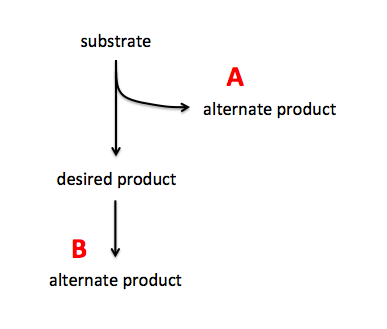20.109(F16):Design gRNA for CRISPRi (Day2)
From Course Wiki
Revision as of 16:10, 26 July 2016 by Noreen Lyell (Talk | contribs)
Contents
Introduction
Brief CRISPR(i)...
Metabolic engineering...
Protocols
Part 1: Select E. coli fermentation gene to target
Your goal in this module is increase the production of either ethanol or acetate, two valuable products of E. coli fermentation. The CRISPRi system targets genes such that transcription of the target is decreased, thus resulting in less protein encoded by the targeted gene.
To increase desired product production, you can either target proteins that use the substrate to generate alternate products (see A in image on right) or you can target proteins that use the desired product to generate alternate products (see B in image on right). In A the substrate is siphoned away from the reaction that generates the desired product and in B the desired product is used as substrate in a subsequent reaction. By eliminating the proteins that catalyze the reactions that result in alternate products, you can ‘’possibly’’ increase production of your desired product.Use the fermentation pathway from ‘’E. coli’’ (included below) and the example above to answer the following questions with your partner.
- Which genes might you target to increase the availability of substrate for ethanol production? For acetate production?
- Which genes might you target to decrease the amount of substrate used is the pathway downstream of ethanol production? For acetate production?
Part 2: Design gRNA for CRISPRi system
Reagents
Next day:
Previous day:
